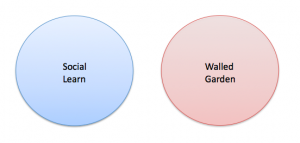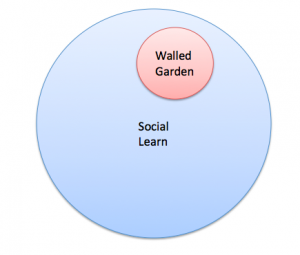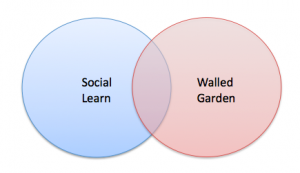September 17th, 2010What is a walled garden?
Social learning is about bringing people and resources together, making meaningful connections between them and enabling discussion. But, as Google Buzz showed, there are limits to the connections that people want to make. Individuals, groups of people, and organisations are all engaged in representation management. There’s some information that we are happy to share with everybody, and some that we want to keep private and there are some discussions that we only want to have with trusted individuals. In the case of The Open University, there is an enormous amount of content that is shared freely via OpenLearn, iTunesU and OUView. At the same time, there are also paid-for courses that you won’t be able to access without registering.
In the case of SocialLearn, we’re aiming to make it as easy as possible to link different resources and different networks. You can sign in to SocialLearn using your Twitter ID, your LinkedIn ID, your Facebook ID and many others. Once you’ve signed in, you can set your privacy levels, and you can join groups with their own privacy levels. On an individual basis this works – but it doesn’t always work on an institutional basis. If another university or organisation joins us, bringing lots of individuals, lots of resources, lots of connections and lots of information, we need a straightforward way for the organisation to manage privacy levels without putting the onus on every student/staff member to deal with this individually. At the same time, we don’t want all those new people cut off from their learning outside that organisation. A related question is, how do we provide minors with safe access to social learning, so that schools can make use of SocialLearn?
We’ve been discussing models for ‘walled gardens’ that allow a high degree of openness and sociability, while allowing us to bring together resources from big providers. Model one is the separate build.
Two builds of SocialLearn – one for Organisation X (which might be a university, school or company). They don’t talk to each other, but they are internally sociable. This is straightforward – but an obvious problem is that it negates the need for SocialLearn. People already have their learning divided up into silos – SocialLearn is trying to bring those silos together.
The next model is the internal garden. In this model, the walled garden sits within SocialLearn and forms a subset of it. This is more complicated to construct, because groups are nested within groups. If the wall around the walled garden is impermeable, this is effectively just a more complicated version of separate walled gardens. If the wall is permeable, then is it useful?
The other obvious model is the overlapping garden – where the walled garden sits partly inside and partly outside SocialLearn. Again, the problem is with what this means in practice. How freely can connections be made between SocialLearn and the walled garden? Can learners move from one to the other without effort, or do they have to pass through a gate and get permission from a gatekeeper at each point?
With all the models, we found we were less interested in the location of the wall, than in its doors and windows. How easy will it be to look over the wall, and to see what, and who, is on the other side? Can we wriggle through gaps in the wall, or do we have to go through a single gateway? Are people, information and resources trapped within the walled garden or can they leave with a permit? Can learners invite friends in, or link up with friends outside their garden?
These questions suggest that the visualisations on this page aren’t helpful in the long run, because our concern is not with location, but with connections and with movement. The metaphor of the walled garden proved limiting. We are now trying to visualise the problem in terms of information flow, or in terms of connected networks. We haven’t solved the problem, but we’re clearer about what solving the problem will involve.



